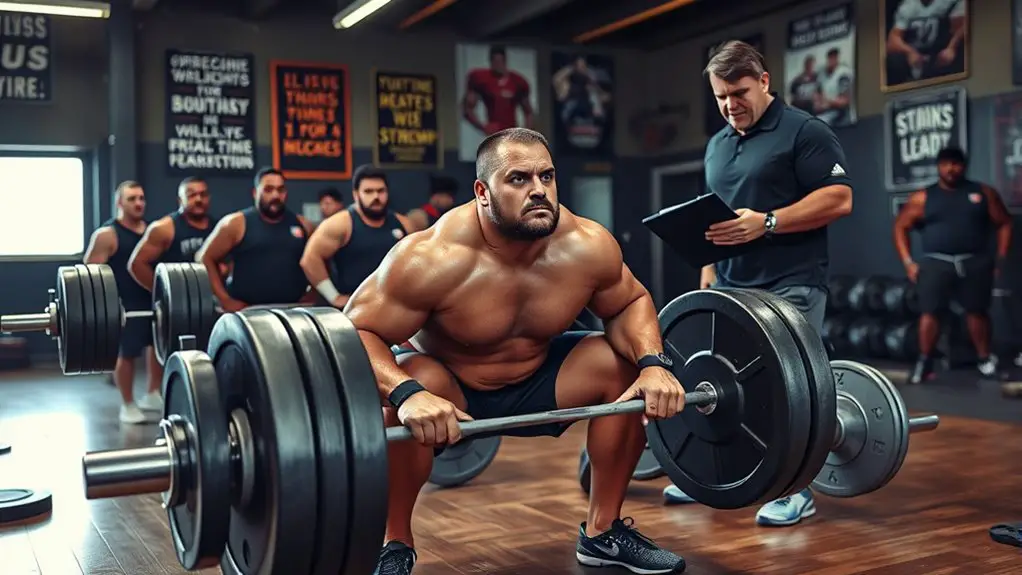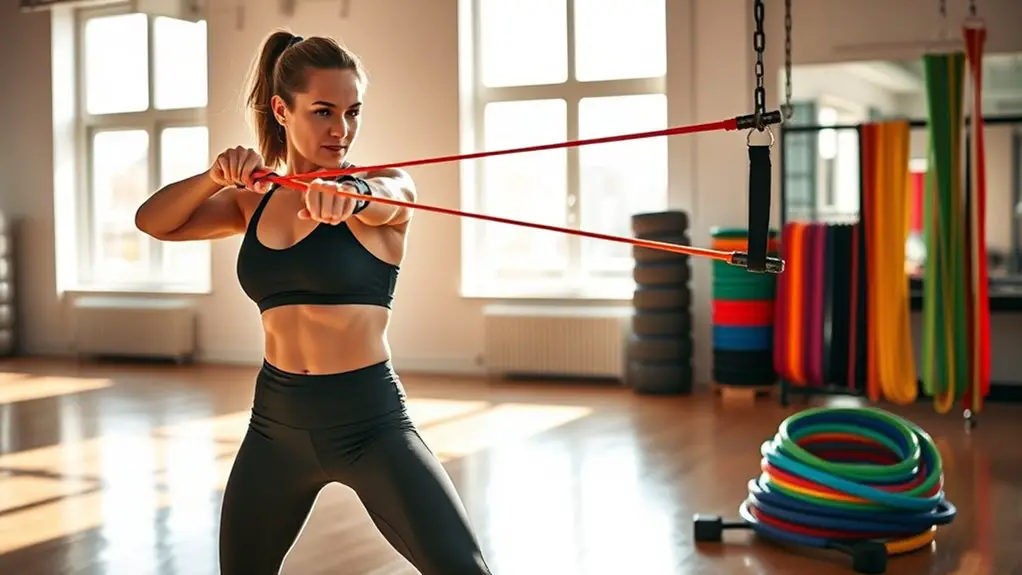To excel as an offensive lineman, focus on building core strength and mastering compound movements like squats and deadlifts for power. Incorporate plyometrics to enhance your agility and reaction time. Don't underestimate the importance of flexibility; regular stretching and mobility work will help you maintain peak performance. Nutrition plays a crucial role too—balance your macros and stay hydrated. Finally, recovery techniques will keep you in the game longer, and there's even more to explore to elevate your training!
Understanding the Unique Demands of Offensive Linemen
When you think about offensive linemen, it's clear that their role requires a unique blend of strength, agility, and endurance. Each position specific technique demands mastery of movement patterns to adapt to various game scenarios. As an offensive lineman, you'll face intense competition that tests your fatigue management and mental toughness. Building resilience isn't just about physical strength; it's also about honing your skills and refining your technique to stay sharp under pressure. Effective teamwork dynamics are essential, as your success relies on seamless communication and cooperation with your teammates. You'll need to anticipate plays, making quick decisions that align with your offensive strategy. Additionally, incorporating strength training into your routine can significantly enhance your performance and reduce injury risk. Preparing for competition readiness means embracing these demands and pushing your limits, ensuring you're always at your best when the game is on the line. Embrace the challenge, and you'll thrive in the trenches of the game!
The Importance of Core Strength
Core strength serves as the foundation for an offensive lineman's performance on the field. It's not just about brute force; it's about control and stability. With strong core muscles, you'll maintain balance during intense plays, giving you the freedom to react quickly and effectively. Incorporating core stabilization techniques in your training regimen can greatly enhance your overall game. Think planks, medicine ball rotations, and stability ball exercises—these aren't just for show; they'll keep you grounded when the game gets tough.
Don't underestimate core strength exercises like hanging leg raises and Russian twists. They build endurance and power, allowing you to hold your ground against powerful defenders. By prioritizing core strength, you're setting yourself up for success. A strong core not only aids in reducing injury risk but also enhances overall performance. So, embrace these workouts and watch how they translate into improved performance on the field. Your body will thank you, and your game will elevate!
Compound Movements for Maximum Power
When it comes to building maximum power, compound movements are essential for offensive linemen. Incorporating squats, deadlifts, and bench presses into your routine will enhance your leg strength, back power, and overall stability. Let's explore how each of these exercises can elevate your performance on the field. Additionally, focusing on explosive strength through Olympic lifts can significantly improve your agility and speed during play.
Squats for Leg Strength
Although many exercises can build leg strength, squats stand out as one of the most effective compound movements for offensive linemen. They engage multiple muscle groups, boosting both strength and leg endurance. Incorporating squat variations like front squats or overhead squats can further enhance your power and stability on the field.
| Squat Variation | Benefits | Recommended Reps |
|---|---|---|
| Back Squat | Builds overall leg strength | 4-6 |
| Front Squat | Improves core stability | 6-8 |
| Box Squat | Enhances explosive power | 4-5 |
| Bulgarian Split Squat | Targets balance and flexibility | 8-10 (per leg) |
| Overhead Squat | Develops shoulder and leg strength | 3-5 |
Utilize these variations to unleash your potential!
Deadlifts for Back Power
Deadlifts pack a powerful punch for building back strength, which is essential for offensive linemen. This compound movement engages multiple muscle groups, making it a game-changer for overall power. Incorporating deadlift variations like sumo or Romanian can target different areas, giving you a well-rounded back workout. These variations not only enhance muscle development but also improve your grip strength—crucial for holding your ground against defenders. Focus on maintaining proper form to maximize benefits and reduce injury risk. Remember, the stronger your back, the better you can anchor yourself during plays. So, embrace the deadlift in your training routine, and watch your performance soar on the field. Your freedom to dominate starts with building that back power!
Bench Press for Stability
Building back power with deadlifts lays a strong foundation, but to truly dominate on the field, you can't overlook the importance of upper body strength. The bench press is a key component in your training arsenal, especially when you incorporate bench press variations for enhanced stability. It's not just about pushing weight; it's about developing a solid core and shoulder stability that'll help you hold your ground against defenders. Focus on techniques like the floor press or incline bench to target different muscle groups, improving overall strength and balance. Remember, effective stability training will translate to better performance during games, allowing you to release your potential and protect your quarterback with confidence. Keep pushing; freedom on the field starts with strength in the gym.
Incorporating Plyometrics for Agility
Plyometric training can greatly enhance your agility on the field, allowing you to react quickly to opponents. Incorporating exercises like box jumps and lateral bounds will help develop your explosive power and coordination. Additionally, these exercises take advantage of the stretch-shortening cycle to maximize muscle potential, contributing to your overall performance. Let's explore how these key plyometric exercises can benefit your game.
Benefits of Plyometric Training
While you might think strength training is all about lifting heavy weights, incorporating plyometrics can greatly enhance your agility on the field. Plyometric training focuses on explosive movements, helping you develop that much-needed explosive power. This type of training improves your ability to change direction quickly, which is essential for an offensive lineman. By integrating plyometrics into your routine, you'll experience increased speed and reaction time, giving you a competitive edge during games. Plus, plyometric benefits extend beyond just agility; they also help in building overall strength and endurance. So, don't underestimate the impact of these dynamic exercises. Embrace plyometrics, and watch how they transform your performance, allowing you to move freely and confidently on the field.
Key Plyometric Exercises
Incorporating just a few key plyometric exercises into your training can greatly enhance your agility on the field. Focus on jumping drills like box jumps and depth jumps; they'll develop your explosive strength and improve your ability to move quickly in tight spaces. Try lateral bounds to boost your side-to-side agility, which is essential for offensive linemen. Don't forget about squat jumps; they'll build power in your legs and enhance your overall performance. Keep your workouts varied and challenging to maintain enthusiasm. Aim for a mix of intensity and recovery to prevent burnout. By integrating these exercises, you'll not only feel more agile but also more free to dominate your opponents on the field. Embrace the challenge and elevate your game!
Flexibility and Mobility Work
Flexibility and mobility work are crucial for offensive linemen, as they enhance performance and reduce injury risk. Incorporating dynamic stretching into your warm-up routine can greatly improve your range of motion and prepare your muscles for action. Focus on movements that mimic the patterns you'll encounter on the field, like lunges and leg swings, to keep your body agile.
Foam rolling is another essential tool in your arsenal. It helps release tension in your muscles and improves blood flow, which can enhance recovery. Spend time rolling out major muscle groups, especially those that feel tight after intense workouts. Additionally, enhanced flexibility allows for fluid movements during games, contributing to better overall performance.
Nutrition Strategies for Strength Development
After ensuring your body is flexible and mobile, it's time to focus on nutrition strategies that fuel strength development. You need to pay attention to meal timing, ensuring you're eating before and after workouts to maximize energy and recovery. Prioritize a solid macronutrient balance—carbs for fuel, protein for muscle repair, and healthy fats for overall health. Proper fueling unlocks your full potential in workouts and helps you engage fully.
Here's a quick table to guide you:
| Nutrient | Importance |
|---|---|
| Carbohydrates | Energy for workouts |
| Protein | Muscle repair and growth |
| Healthy Fats | Hormone production |
Don't forget hydration strategies, as staying well-hydrated supports performance. Finally, focus on nutrient-dense foods—think whole grains, lean proteins, and plenty of fruits and veggies. By integrating these strategies, you'll be on your way to maximizing your strength gains and feeling great on the field.
Recovery Techniques to Enhance Performance
While you might focus on strength training, recovery techniques are just as essential for enhancing your overall performance. Incorporating active recovery, like light jogging or cycling, keeps your blood flowing and helps prevent stiffness. Foam rolling is another great tool to release muscle tightness and improve flexibility. Don't underestimate the power of contrast baths; alternating between hot and cold water can reduce muscle soreness and speed up recovery.
Proper hydration is important, too—staying hydrated not only supports your muscles but also helps with recovery. Additionally, maintaining a balanced diet that includes protein from lean sources plays a crucial role in muscle repair and growth. Sleep optimization is crucial; aim for 7-9 hours of quality sleep each night to allow your body to repair itself. Finally, consider regular massage therapy to alleviate tension and promote relaxation. By integrating these recovery techniques, you'll not only feel better but also enhance your performance on the field.
Frequently Asked Questions
How Often Should Offensive Linemen Train Each Week?
Ever wondered how often you should be training each week? It's not just about hitting the gym; it's about finding that ideal balance. Training frequency matters, but so does recovery. You can't push your limits without giving your body time to heal. Aim for 3 to 5 sessions weekly, ensuring you include rest days for best recovery. That way, you'll release your potential and feel free to conquer your goals.
What Are the Best Exercises for Grip Strength?
When it comes to improving your grip strength, you can't go wrong with a few effective grip exercises. Incorporating exercises like dead hangs, farmer's carries, and wrist curls can really boost your grip power. Plus, using grip tools like hand grippers and resistance bands can add variety to your routine. Remember, a strong grip not only enhances your overall strength but also gives you the freedom to excel in various physical activities.
How Should I Adjust My Training for Game Day?
Game day's like a finely tuned engine—every part needs to run smoothly. To adjust your training, focus on light, quick workouts that keep you sharp without wearing you down. Prioritize game day preparation by ensuring you're well-rested and hydrated. Nutrition considerations are essential, so fuel up with carbs and lean proteins. Stay loose and mentally focused, letting those pre-game jitters propel you to peak performance when it really counts.
Are There Specific Warm-Up Routines for Linemen?
Absolutely, there are specific warm-up routines that can really benefit you. Start with dynamic stretches to get your muscles activated; think leg swings and arm circles. Then, incorporate mobility drills like hip openers and torso twists to improve your range of motion. This combination helps prevent injuries and prepares your body for the intensity ahead. You'll feel more agile and ready to dominate on the field, allowing you the freedom to perform at your best.
How Do I Prevent Injuries During Strength Training?
An ounce of prevention's worth a pound of cure. To prevent injuries during strength training, focus on proper form and technique. Always warm up before your workouts, and don't skip stretching afterward. Gradually increase your weights, listening to your body along the way. Incorporate rest days to let your muscles recover, and stay hydrated. Remember, freedom in your training comes from staying healthy and injury-free, so prioritize injury prevention every step of the way.




